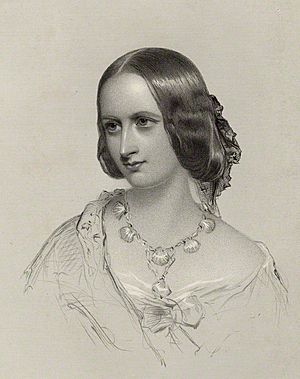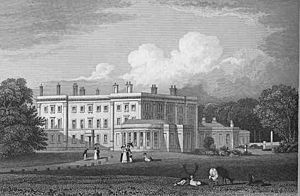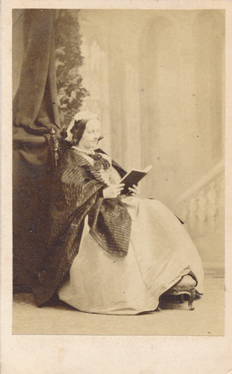Elizabeth Campbell, Duchess of Argyll facts for kids
Quick facts for kids
The Duchess of Argyll
CI VA
|
|
|---|---|
 |
|
| Born | 30 May 1824 |
| Died | 25 May 1878 (aged 53) London, England |
| Spouse(s) | |
| Issue | John Campbell, 9th Duke of Argyll Lord Archibald Campbell Lord Walter Campbell Edith Percy, Duchess of Northumberland Lord George Campbell Lady Elizabeth Clough-Taylor Lord Colin Campbell Lady Victoria Campbell Lady Evelyn Baillie-Hamilton Lady Frances Balfour Lady Mary Glyn Lady Constance Emmott |
| Father | George Sutherland-Leveson-Gower, 2nd Duke of Sutherland |
| Mother | Lady Harriet Howard |
| Occupation | Mistress of the Robes to Queen Victoria |
Elizabeth Georgiana Campbell, Duchess of Argyll (born Leveson-Gower; May 30, 1824 – May 25, 1878) was an important British noblewoman. She was also a strong supporter of the movement to end slavery.
Elizabeth was born into a very rich family. Her father was the 2nd Duke of Sutherland. Her mother, Lady Harriet Howard, was famous for hosting political events. In 1844, Elizabeth married George Campbell, Marquess of Lorne. He was the oldest son of the 7th Duke of Argyll. When her husband became the Duke of Argyll in 1847, Elizabeth became the Duchess of Argyll.
Like her mother, the Duchess of Argyll was a leading voice against slavery. They helped write a letter called An Affectionate and Christian Address of Many Thousands of Women of Great Britain and Ireland to Their Sisters, the Women of the United States of America. This letter asked for slavery to end. Over half a million British women signed it. The Duchess and her mother often welcomed the American writer and anti-slavery activist Harriet Beecher Stowe when she visited England. The Duchess and Beecher Stowe were good friends and wrote letters to each other.
In 1868, the Duchess of Argyll became the Mistress of the Robes to Queen Victoria. This was an important role in the Queen's household. She held this position until 1870, when she had to leave due to poor health. In 1877, she was made a member of the new Order of the Crown of India. She passed away in 1878 in London while having a meal with William Ewart Gladstone, who was a former Prime Minister.
Contents
Early Life and Family Background
Lady Elizabeth Georgiana Leveson-Gower grew up with a lot of wealth. Her grandmother, Elizabeth Gordon, was the Countess of Sutherland. She managed huge estates in the Scottish Highlands. These lands became even bigger when her grandmother married George Leveson-Gower in 1785. He later became the 1st Duke of Sutherland.
In 1823, Elizabeth's father, George, married Lady Harriet Howard. Elizabeth was born the next year, on May 30, 1824. She was their oldest daughter. She later had three younger brothers and two younger sisters.
Because her family owned estates in both Scotland and England, Elizabeth traveled a lot as she grew up. Their main home was the grand Stafford House in London. They also lived on many country estates. Elizabeth's parents, especially her mother Harriet, had very active social lives. Harriet was known for being a political hostess and a close friend to the young Queen Victoria. In 1833, Elizabeth's grandfather passed away. Her father then became the 2nd Duke of Sutherland and inherited all the family's property.
Her Marriage and New Home
In 1842, Lady Elizabeth met George Douglas Campbell, Marquess of Lorne. This happened while she was with Queen Victoria at Taymouth Castle. George was the oldest son of the 7th Duke of Argyll. They got married on July 31, 1844, at the Leveson-Gower family estate, Trentham Hall. The Archbishop of York led their wedding ceremony.
Elizabeth's wealth was very helpful to the Argyll family, as their estate had some debts. Their marriage brought together two of Scotland's largest landowning families.
After they married, George's father gave the young couple a place called Rosneath. Elizabeth was a very religious person. She had been raised in the Anglican faith. However, she changed to the Church of Scotland after her marriage. She took her first communion in that faith later that year. Elizabeth also strongly supported the Scottish Episcopal Church. She and George shared similar interests in liberal politics. Elizabeth was seen as a dignified and cultured person. George found her to be very well-read, especially on many topics he hadn't explored yet.
Life as Duchess of Argyll
George became the 8th Duke of Argyll on April 25, 1847, after his father passed away. This meant Elizabeth became the Duchess of Argyll. Their main family homes included Argyll Lodge in London, and the family's historic castle, Inveraray Castle in Argyllshire. They also kept Rosneath.
Their first child, John, was born within a year of their marriage. They would go on to have a total of twelve children: five sons and seven daughters. The Argyll household was very organized and proper. They had set times for prayer, breakfast, lunch, and dinner. Children were not expected to cry unless there was a "real cause," like the death of a family pet.
The Duchess of Argyll had many children and suffered from poor health. In 1868, she had a stroke, which made her partly unable to move. Because of this, her husband had to take on much of the responsibility for raising their children. Her third daughter, Lady Victoria, who also had health problems from poliomyelitis, helped care for her mother.
When their children grew up, their marriages sometimes put a strain on the family's money. All but one of their children eventually married. Their oldest son, John, married Princess Louise, who was Queen Victoria's fourth daughter, in 1871. John later became the Governor General of Canada in 1878.
Fighting Against Slavery
Like her mother, the Duchess of Sutherland, the Duchess of Argyll was a strong supporter of the movement to end slavery. Elizabeth was deeply moved by the anti-slavery novel Uncle Tom's Cabin, which was published in 1852. The next year, at her mother's house, the Duchess helped write a letter. It was called An Affectionate and Christian Address of Many Thousands of Women of Great Britain and Ireland to Their Sisters, the Women of the United States of America.
This letter was signed by 562,848 women. It asked for slavery to end. It pointed out that slavery did not recognize slave marriages, separated parents from their children, and stopped slaves from getting Christian education. The letter was sent to Harriet Beecher Stowe, the American author of Uncle Tom's Cabin. The Duchess of Argyll and Harriet Beecher Stowe became friends and wrote many letters to each other. Harriet Beecher Stowe often visited the duchesses of Sutherland and Argyll when she came to England. Their connections helped her meet important politicians. The Duke and Duchess of Argyll were also friends with Charles Sumner, an American politician who was against slavery.
Royal Duties and Later Life
In December 1868, Lady Campbell was chosen to be the Mistress of the Robes to Queen Victoria. She took over from the Duchess of Wellington. This was part of William Ewart Gladstone's first government. She resigned from this role in 1870 because of her poor health. Her sister-in-law then took over the position.
In December 1877, Queen Victoria created a new honor called the Order of the Crown of India. The Duchess of Argyll was one of the first royal and noblewomen to receive this honor. She was also a member of the Royal Order of Victoria and Albert, Second Class.
The Duchess of Argyll passed away on May 25, 1878, in London. She was having dinner with William Ewart Gladstone at the time. She is buried at Kilmun Parish Church.
Her Children

The Duke and Duchess of Argyll had 12 children:
- John Campbell, 9th Duke of Argyll (August 6, 1845 – May 2, 1914); he married Princess Louise of the United Kingdom in 1871.
- Lord Archibald Campbell (December 18, 1846 – March 29, 1913); he married Janey Callendar. Their family included Niall Campbell, 10th Duke of Argyll.
- Lord Walter Campbell (July 30, 1848 – May 2, 1889); he married Olivia Clarkson Miln in 1874. He was the grandfather of Ian Campbell, 11th Duke of Argyll.
- Lady Edith Campbell (November 7, 1849 – July 6, 1913); she married Henry Percy, 7th Duke of Northumberland in 1868.
- Lord George Granville Campbell (December 25, 1850 – April 21, 1915); he married Sybil Alexander in 1879.
- Lady Elizabeth Campbell (February 14, 1852 – September 24, 1896); she married Lt.-Col. Edward Harrison Clough-Taylor in 1880.
- Lord Colin Campbell (March 9, 1853 – June 18, 1895); he married Gertrude Elizabeth Blood in 1881.
- Lady Victoria Campbell (May 22, 1854 – July 6, 1910).
- Lady Evelyn Campbell (August 17, 1855 – March 22, 1940); she married James Baillie-Hamilton in 1886.
- Lady Frances Campbell (February 22, 1858 – February 25, 1931); she married the architect Eustace Balfour. He was the brother of Prime Minister Arthur Balfour.
- Lady Mary Emma Campbell (September 22, 1859 – March 22, 1947); she married Edward Carr Glyn, who was the Bishop of Peterborough.
- Lady Constance Harriett Campbell (November 11, 1864 – February 9, 1922); she married Charles Emmott in 1891.



